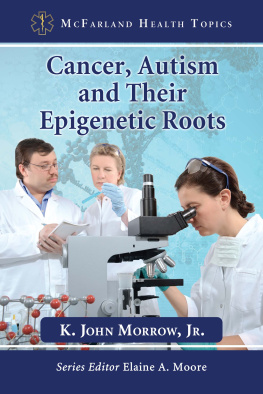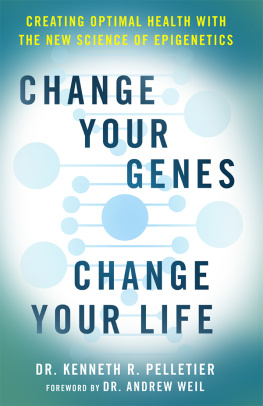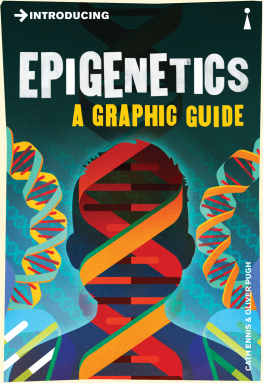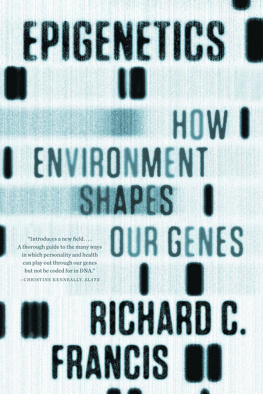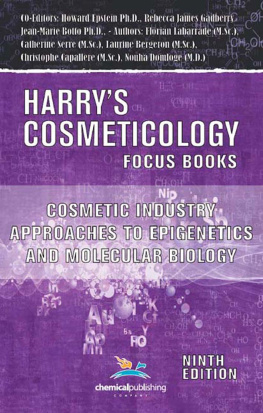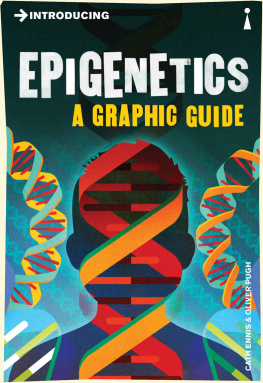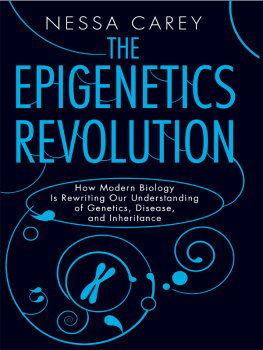Epigenetics in Health and Disease
Igor Kovalchuk, Ph.D., MD
Olga Kovalchuk, Ph.D., MD
Vice President, Publisher: Tim Moore
Associate Publisher and Director of Marketing: Amy Neidlinger
Editorial Assistant: Pamela Boland
Development Editor: Russ Hall
Operations Specialist: Jodi Kemper
Assistant Marketing Manager: Megan Graue
Cover Designer: Alan Clements
Managing Editor: Kristy Hart
Senior Project Editor: Lori Lyons
Copy Editor: Charlotte Kughen
Proofreader: Sarah Kearns
Indexer: Angela Martin
Senior Compositor: Gloria Schurick
Manufacturing Buyer: Dan Uhrig
2012 by Pearson Education, Inc.
Publishing as FT Press
Upper Saddle River, New Jersey 07458
FT Press offers excellent discounts on this book when ordered in quantity for bulk purchases or special sales. For more information, please contact U.S. Corporate and Government Sales, 1-800-382-3419, .
Company and product names mentioned herein are the trademarks or registered trademarks of their respective owners.
All rights reserved. No part of this book may be reproduced, in any form or by any means, without permission in writing from the publisher.
Printed in the United States of America
First Printing May 2012
ISBN-10: 0-13-259708-X
ISBN-13: 978-0-13-259708-1
Pearson Education LTD.
Pearson Education Australia PTY, Limited.
Pearson Education Singapore, Pte. Ltd.
Pearson Education Asia, Ltd.
Pearson Education Canada, Ltd.
Pearson Educacin de Mexico, S.A. de C.V.
Pearson EducationJapan
Pearson Education Malaysia, Pte. Ltd.
Library of Congress Cataloging-in-Publication Data
Kovalchuk, Igor.
Epigenetics in health and disease / Igor Kovalchuk, Olga Kovalchuk. 1st ed.
p. cm.
Includes index.
ISBN 978-0-13-259708-1 (hardcover : alk. paper)
1. EpigeneticsHistory. 2. EpigeneticsHealth aspects. 3. Pathology, Cellular. 4. CellsMorphology. I. Kovalchuk, Olga, MD. II. Title.
QH430.K68 2012
571.936dc23
2012007714
Dedicated to Anna.
Acknowledgments
We would like to thank Zoe Migicovsky, Corinne Sidler, Alena Babenko, Melanie Kalischuk, Andriy Bilichak, Stephanie Wickersham, Joel Stimson, Aki Matsuoka, and Munima Alam for helping us in writing this book, collecting literature, and checking chapters for comprehension. Special thanks to Valentina Titova for the tremendous help in proofreading the book.
About the Authors
Igor Kovalchuk, Ph.D., MD, is Professor and Board of Governors Research Chair at the Department of Biological Sciences, University of Lethbridge (Alberta, Canada). He edits Frontiers in Plant Microbe Interaction, Frontiers in Epigenomics, and other journals. As principal investigator in the universitys Plant Biotechnology laboratory, he studies genetic and epigenetic regulation of plant response to stress, including the transgenerational effects of stress and microevolution of plant stress tolerance/resistance.
Olga Kovalchuk, Ph.D., MD is Professor and Board of Governors Research Chair and CIHR Chair in Gender and Health at the University of Lethbridge and a member of the editorial boards of Mutation ResearchFundamental and Molecular Mechanisms of Mutagenesis and Environmental and Molecular Mutagenesis. She researches the role of epigenetic dysregulation in carcinogenesis; epigenetic regulation of cancer treatment responses; radiation epigenetics and role of epigenetic changes in genome stability and carcinogenesis; radiation-induced oncogenic signaling; and radiation-induced DNA damage, repair, and recombination.
1. Historical perspective
Genetics can be broadly defined as the science studying the mechanisms of inheritance in general and genes in particular. Epigenetics can be, in part, defined as the branch of biology dealing with the mechanisms of inheritance. In contrast to genetics, epigenetics involves the control of gene expression that is not accompanied by any changes in DNA sequence. Epigenetics deals with the mechanisms of heredity which do not involve modifications of DNA sequence and are reversible in nature.
Success of a certain population depends on the fine balance between the ability to retain a given genotype in the stable environment and the ability to evolve by modification in response to substantial environmental changes. Changes in the genome can be dual in nature; they might deal with stable physical changes in DNA sequence leading to mutations and reversible chemical modifications of nucleotides or chromatin structure leading to epimutations. Mutations are the basis of genetic changes.
This book introduces you to the concept of epigenetics and epigenetic regulation. The book discusses processes of evolution in light of current understanding of the role of epigenetics and describes the role of epigenetic regulations in the growth and development of somatic cells, tissue differentiation, and the maintenance of epigenetic states in various cells of the same organisms. Furthermore, the book provides an introduction to an in-depth understanding of the role of epigenetics in the mechanisms of inheritance and interaction with the environment. The chapters also describe the role of epigenetics in health and disease. Finally, the book introduces you to the concepts of silencing, co-suppression, and paramutations, and discusses the role of epigenetics in these processes.
This book is aimed primarily at students beginning to study epigenetics, whether at the undergraduate or graduate level. It may also be essential reading for research scientists in the field of epigenetics, genome stability, stress tolerance and adaptation, transgeneration effects, genome evolution, and other related fields, as well as anyone who simply wishes to know more about the field of epigenetics.
The mechanisms of environmental influences on the phenotypic appearance of organisms and inheritance were developed nearly two centuries ago and represented a prominent part of the descriptive work performed by Jean-Baptiste Lamarck and Charles Darwin. Although their ideas were often viewed as too preliminary and nave, it was those ideas that laid a solid and important foundation for the development of the field of epigenetics. Epigenetics has a lot to do with an organisms interaction with the environment; therefore, it is important to review how our understanding of the interactions between the organisms genome, surroundings, and phenotype has developed over time.
The French biologist Jean-Baptiste Lamarck (17441829), who is credited with the first use of the word biology, was the first scientist who proposed a theory of evolution. He used the term transformation rather than evolution to suggest that organisms change and transform as the result of a new need that continues to make itself felt. His first reference to evolution as a process of less complex species becoming more complex appeared in 1800 in his Floreal lecture. Within next 20 years, Lamarck published three important works (Recherches sur lorganisation des corps vivants, 1802; Philosophie Zoologique, 1809; Histoire naturelle des animaux sans vertbres (in seven volumes, 18151822) in which he developed his ideas of evolution and formulated the laws that described evolution as a process. Lamarck writes:
Law 1: Life, by its own forces, continually tends to increase the volume of every body which possesses it and to enlarge the size of its parts up to a limit which it brings about itself. Law 2: The production of a new organ in an animal body results from the appearance of a new want or need, which continues to make itself felt, and from a new movement which this want gives birth to and maintains.


